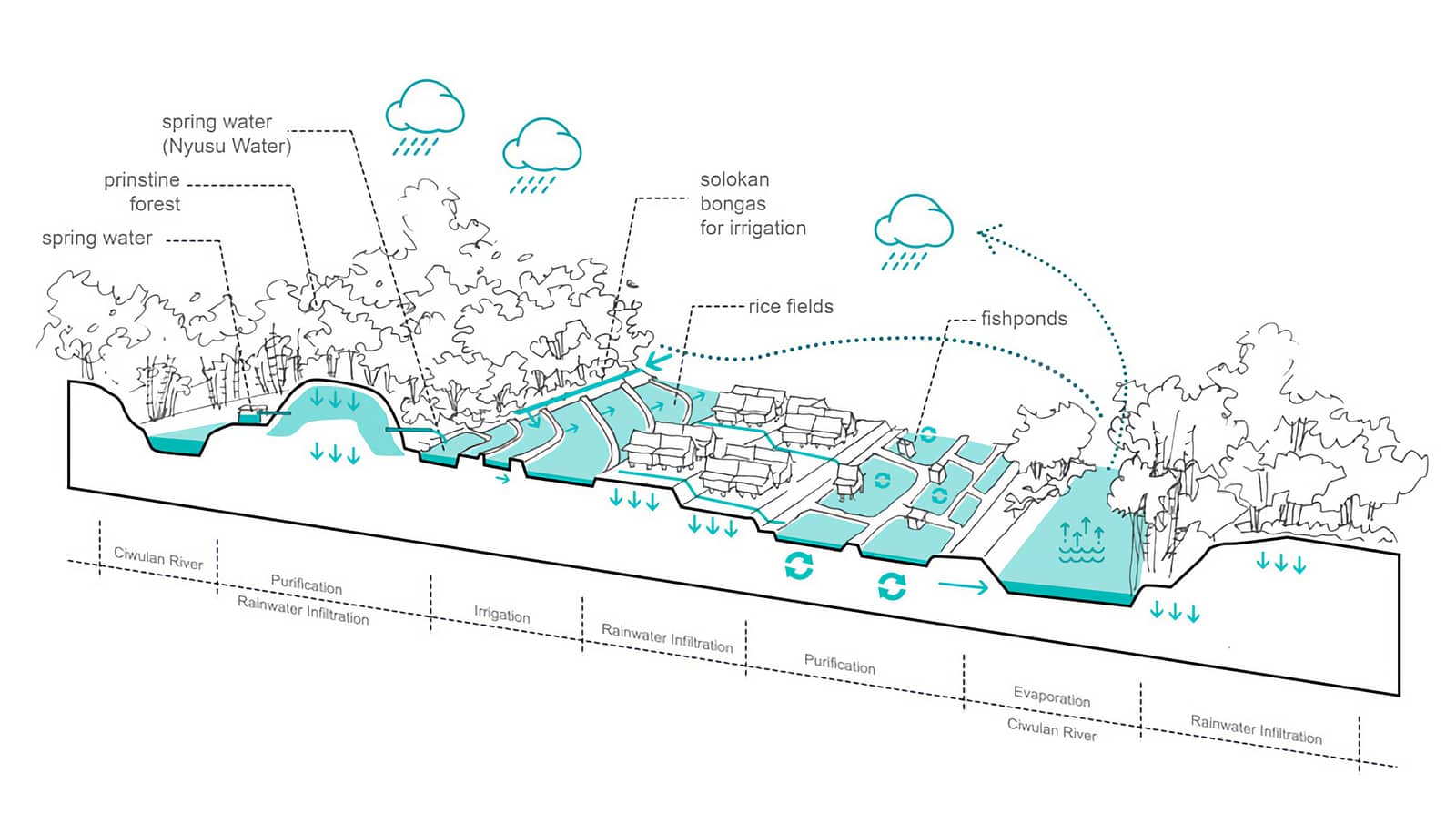Water Stories of Kampung Naga, Indonesia
Downloads
DOI:
https://doi.org/10.7480/spool.2020.2.5047Keywords:
Circular Water Stories, Heritage Landscape, Indonesia, Kampung Naga, landscape architectureAbstract
Rapid urbanisation and sprawling growth have become constant hindrances to nature in most developing countries. West Java is the most populated province in Indonesia under rapid urbanisation. In this rural area of the province, however, there is a traditional Sundanese hamlet called Kampung Naga that has succeeded in cohesively cohabiting with nature. This article discusses how the interaction of water, ecology, and anthropo-systems influences the spatial layout of the village, forms its cultural landscape, and shapes people’s social life. In addition to its sustainability, this article also reflects on the challenges of the possible application of this heritage landscape system in wider contexts. Three lessons can be learned from the water heritage system of Kampung Naga: (1) Understanding how the workings of the natural landscape are critical in determining the living space development; (2) The circular water system and its metabolism could only be maintained by integrating it into its cultural, social, and economical values; (3) Community planning and water circularity create a self-sustained living unit in Kampung Naga. Findings from this study can improve our body of knowledge of potential solutions for future spatial development, where the relationship between human and water could be profoundly re-established.
How to Cite
Published
License
Copyright (c) 2020 Ayu Tri Prestasia, Boomi Kim

This work is licensed under a Creative Commons Attribution 4.0 International License.

References
As’ari, R & Hendriawan, N. (2016). Kajian Nilai Kearifan Lokal Masyarakat Adat Kampung Naga dalam Pengelolaan Lingkungan Berbasis Mitigasi Bencana [Study of the Values of Local Wisdom of Kampung Naga’s Indigenous People in the Environmental Management based on Disaster Mitigation]. Prosiding Seminar NasionalGeografi UMS 2016. ISBN: 978-602-361-044-0
As’ari, R., Rohmat, D., Maryani, E., & Ningrum, E. (2019). Management of water resources based on local wisdom: a development study of Kampung Naga as a field laboratory of Geography Education in Tasikmalaya, West Java. In IOP Conference Series: Earth and Environmental Science (Vol. 243, No. 1, p. 012002). IOP Publishing.
As’ari, R., Sari, W., & Meilani, D. (2018). Pelestarian Sungai Ciwulan Berbasis Kearifan Lokal Leuweung Larangan di Kampung Adat Naga Kabupaten Tasikmalaya [Conservation of Ciwulan River based on the Local Wisdom Leuweng Larangan in Traditional Kampung Naga, Tasikmalaya Regency]. Prosiding Seminar Nasional Geografi UMS IX 2018.
Burkett, M.H. (2020). Silent and Unseen: Stewardship of Water Infrastructural Heritage. In C. Hein (Ed.), Adaptive Strategies for Water Heritage (pp. 21-37). Retrieved from: https://doi.org/10.1007/978-3- 030-00268-8_2
Darmayanti, T. E. (2018). Sundanese Traditional Houses in Kampung Naga, West Java as Part of Indonesian Cultural Tourism. Journal of Tourism, 3(8), 57-65.
Firman, T. (2008). The Patterns of Indonesia’s Urbanisation, 1980-2007. Population Association of America, 2008.
Hein, C., van Schaik, H., Six, D., Mager, T., Kolen, J., Ertsen, M., Nijhuis, S, & Verschuure-Stuip, G. (2020). Introduction: Connecting Water and Heritage for the Future. In C. Hein (Ed.) Adaptive Strategies for Water Heritage (pp. 1-18). Cham: Springer. https://doi.org/10.1007/978-3-030-00268-8_1
Iryana, W. (2014). The Mythology of Kampung Naga Community. Al-Albab, 3(2).
Iskandar, J. & Iskandar, B. S. (2018). Etnoekologi, Biodiversitas Padi dan Modernisasi Budidaya Padi: Studi Kasus Pada Masyarakat Baduy dan Kampung Naga [Ethnoecology, Rice Biodiversiity and Modernisation of Rice Cultivation: A Case Study of the Baduy and Kampung Naga Communities]. Jurnal Biodjati, 3(1), 47-62.
Khairunnisa, M. (2014). Kosmologi Ruang Adat Sebagai Identitas Pemukiman Kampung Naga, Tasikmalaya-Jawa Barat [The Cosmology of Costumary Spaces as the Identity of the Settlement in Kampung Naga- West Java]. Teknik, 35(1), 49-55.
Maria, S., Indrawati, D., & Astuti, R. (1995). Sistem Keyakinan pada Masyarakat Kampung Naga dalam Mengelola Lingkungan Hidup (Studi tentang Pantangan dan Larangan) [The Belief System of the People of Kampung Naga in Managing the Environment (A Study of Taboo & Prohibition)]. Direktorat Jenderal Kebudayaan
Mulyana W. (2014). Rural-Urban Linkages: Indonesia Case Study. Working Paper Series Nº 126. Working Group: Development with Territorial Cohesion. Territorial Cohesion for Development Program. Rimisp, Santiago, Chile.
Prawiro, A. M. B. (2015). Religion and the Local Tradition of Life Cycle Rituals in Kampung Naga, West Java. Al-Albab, 4(1), 55-68.
Qodariah, L., & Armiyati, L. (2013). Nilai-Nilai Kearifan Lokal Masyarakat Adat Kampung Naga sebagai Alternatif Sumber Belajar [The Values of Local Wisdoms of the Indigenous Community of Kampung Naga as an Alternative Source of Study]. SOCIA: JurnalIlmu-IlmuSosial, 10(1), 10-20.
Sudarwandi, M. M. (2016). A Study on House Pattern of Kampung Naga in Tasikmalaya, Indonesia. International Journal of Technology Enhancements and Emerging Engineering Research, 4(58), 2347- 4289.
Utami, M. N., Ardi, F., Wildan, M., Saputro, A. D., & Utari, R. R. A. (2014). Kajian Sustainable Material Bambu, Batu, Ijuk dan Kayu pada Bangunan Rumah Adat Kampung Naga [Study of Sustainable Material of Bamboo, Stone, Palm Fiber and Wood in the Traditional House of Kampung Naga]. REKA KARSA, 2(2).
Wahadamaputera, S., Nauw, M. M., Sondaka, A., Ningrum, E. K., & Maulana, C. A. (2014). Pengolahan dan Pemanfaatan Elemen Air Sebagai Kearifan Lokal pada Arsitektur Kampung Naga [The Management and Utilisation of Water Elements as a Local Wisdom in the Architecture of Kampung Naga]. REKA KARSA, 2(3).



